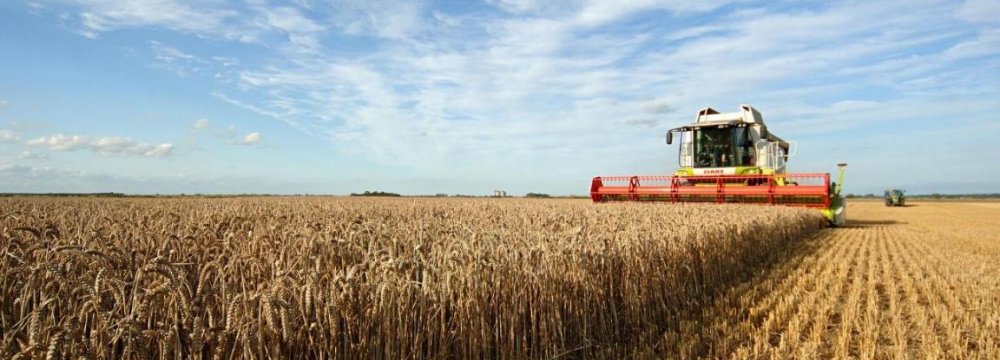Despite its large swaths of unfertile land and desert, Iran is a large and proud producer of wheat. This looks set to change, however, as regional politics and a national water crisis drive the country towards increasing imports.
Iran’s current government, which has been in power for over a year, has given wheat a central place in its economic policies. In a letter to the minister of agricultural jihad, President Rouhani put wheat at the top of a list of eight goods in which self-sufficiency should be reached.
Stringent EU and US sanctions, which have made trade in basic commodities significantly more expensive and difficult, have prompted Iran to create what it calls a ‘resistance economy’, or an economy which can only minimally be affected by outside influences and is thus diversified and self-sufficient. Wheat is particularly important, as it is, together with rice and barley, the prime staple food for Iranians. Iran consumes about 11 million tons of wheat annually and has strategic reserves amounting to 5.3 million tons. Metro stations and other public spaces have on occasions been decorated with posters explaining the importance of the resistance economy and obtaining autarky in such fields as wheat production.
However, the latest government’s efforts to attain self-sufficiency in wheat have been only modestly successful as various recent developments have put a spanner in its works.
In recent years, water consumption has increased drastically while rainfall has been limited and underground water reserves have been gradually emptied. The agricultural sector is the prime culprit of this trend as it accounts for more than 90 percent of yearly water consumption. Wheat production in particular requires large amounts of water with estimates showing that the production of each kilo requires about 1,300 liters of water.
Some analysts believe that Iran has already passed its physical capability of achieving self-sufficiency in wheat. They point to statistics showing that the peak of self-sufficiency had been reached in the years 2002-2004, after which demand has increasingly diverged from supply.
Indeed, the national drought has already led to a relatively poor harvest this year, in turn fuelling imports. The value of grain imports during the first semester of the Persian year ending in March 2015 has increased by 124 percent compared to the similar period last year. Due to this increase, Iran now spends more money importing wheat than on any other product. If current rates continue, Iran will import 7.4 million tons of grain in the Persian year 2014/2015, which is almost half of domestic needs.
The Rouhani administration has acknowledged the water crisis and stated it will do everything in its power to stop the spread of drought. So far it has not stepped back from its promise of achieving self-sufficiency in wheat, but neither has it acknowledged a link between its wheat policies and exacerbating drought.
The changing economic situation in Russia is another reason why Iran looks set to start importing more wheat. Recent Western sanctions against Russia have raised borrowing costs and constricted lending and export opportunities for the fourth largest producer of wheat. Despite that, Russia has stated it will maintain current production and looks to Iran to fill the gaps in its exports.
Last month, the Iranian government announced it would reopen the Iran-Russia bank which had been in disuse since the 1979 Islamic Revolution. One of the purposes of this bank would be to bypass sanctions and ease wheat and other agro transactions between the two neighbors.
Tehran and Moscow have also discussed a possible barter of Russian wheat in return for Iranian oil. According to officials involved in the talks, Russia is ready to supply between 1 and 2 million tons of grain a year, amounting to $250-$500 million. A deputy minister of industry, mine and trade told ISNA earlier: “given that our economy is sanctioned and sanctions are also being implemented against Russia, we can [in cooperation] with Russia solve some of our problems.”
Lastly, some commentators believe that the subsidy reform plan, a legacy from the previous government, has not been consistent with President Rouhani’s policies to attain self-sufficiency. In response to accusations against former president Mahmoud Ahmadinejad’s government that it bought wheat from domestic producers at sub-market rates, Rouhani has increased the official buying price of wheat from 8,000 to 10,500 rials per kilogram (about $0.3). However, as the government also subsidizes wheat imports, which are currently priced at about 8,700 rials per kilogram, buyers are inclined to import foreign wheat, as opposed to the more expensive domestically grown produce.
Nonetheless, a series of measures recently vowed to be taken by the ministry of agriculture could be considered as remedy to the domestic agro production, including wheat production. The ministry announced this week that it would allocate 13,000 billion rials in investment to modernize irrigations systems in around 200,000 hectares of farmlands across the country. The government already announced other plans to promote efficient management of water resources in the agriculture sector.
Latest data shows that 10.2 million tons of wheat was produced domestically in the farming year ending September 30, 2014, indicating a 10 percent increase compared to one year earlier. Officials hope their plans, if implemented, will accelerate the production pace of wheat in just few years, though critics remain doubtful if it is even economical for the country to avoid importing the basic product.
Caption: Iran is a large producer of wheat.





